7PJMN002W BIM & Integrated Practice: Digital Strategy Report
VerifiedAdded on 2022/08/23
|10
|1998
|24
Report
AI Summary
This report details a student's assignment on Building Information Modeling (BIM) and digital strategy, focusing on the construction of the St-Louis villa. It utilizes Revit software for modeling and simulation, emphasizing the importance of BIM in improving efficiency, communication, and collaboration throughout the construction process. The report covers planning, budgeting, and visualization techniques, along with a discussion of potential risks associated with BIM implementation and mitigation strategies. A Gantt chart outlines project milestones, costs, and resource allocation in accordance with ISO 19650 standards. The report also explores the academic side of BIM, its digital journey, and its integration into a digital strategy, providing a comprehensive overview of BIM's application in the construction industry.
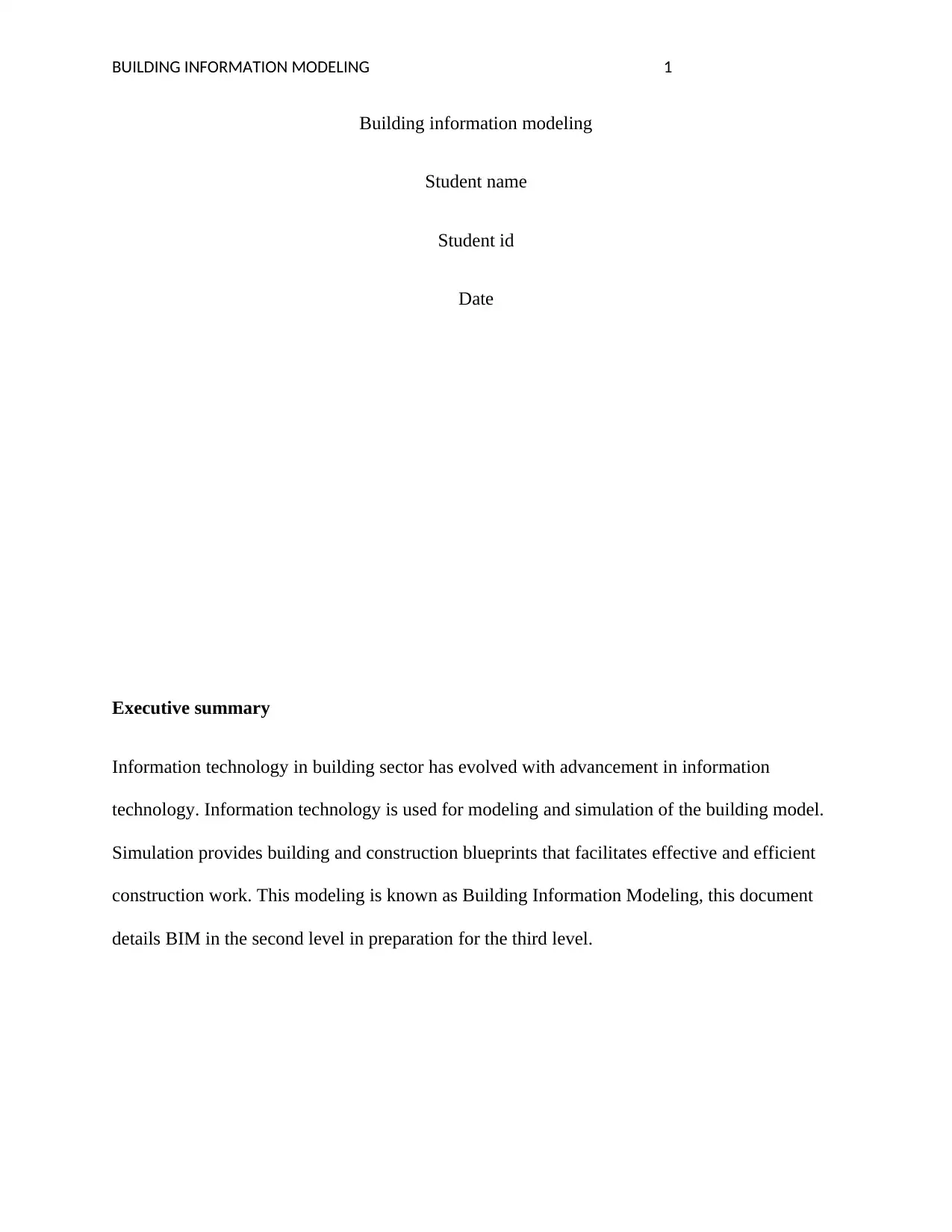
BUILDING INFORMATION MODELING 1
Building information modeling
Student name
Student id
Date
Executive summary
Information technology in building sector has evolved with advancement in information
technology. Information technology is used for modeling and simulation of the building model.
Simulation provides building and construction blueprints that facilitates effective and efficient
construction work. This modeling is known as Building Information Modeling, this document
details BIM in the second level in preparation for the third level.
Building information modeling
Student name
Student id
Date
Executive summary
Information technology in building sector has evolved with advancement in information
technology. Information technology is used for modeling and simulation of the building model.
Simulation provides building and construction blueprints that facilitates effective and efficient
construction work. This modeling is known as Building Information Modeling, this document
details BIM in the second level in preparation for the third level.
Paraphrase This Document
Need a fresh take? Get an instant paraphrase of this document with our AI Paraphraser
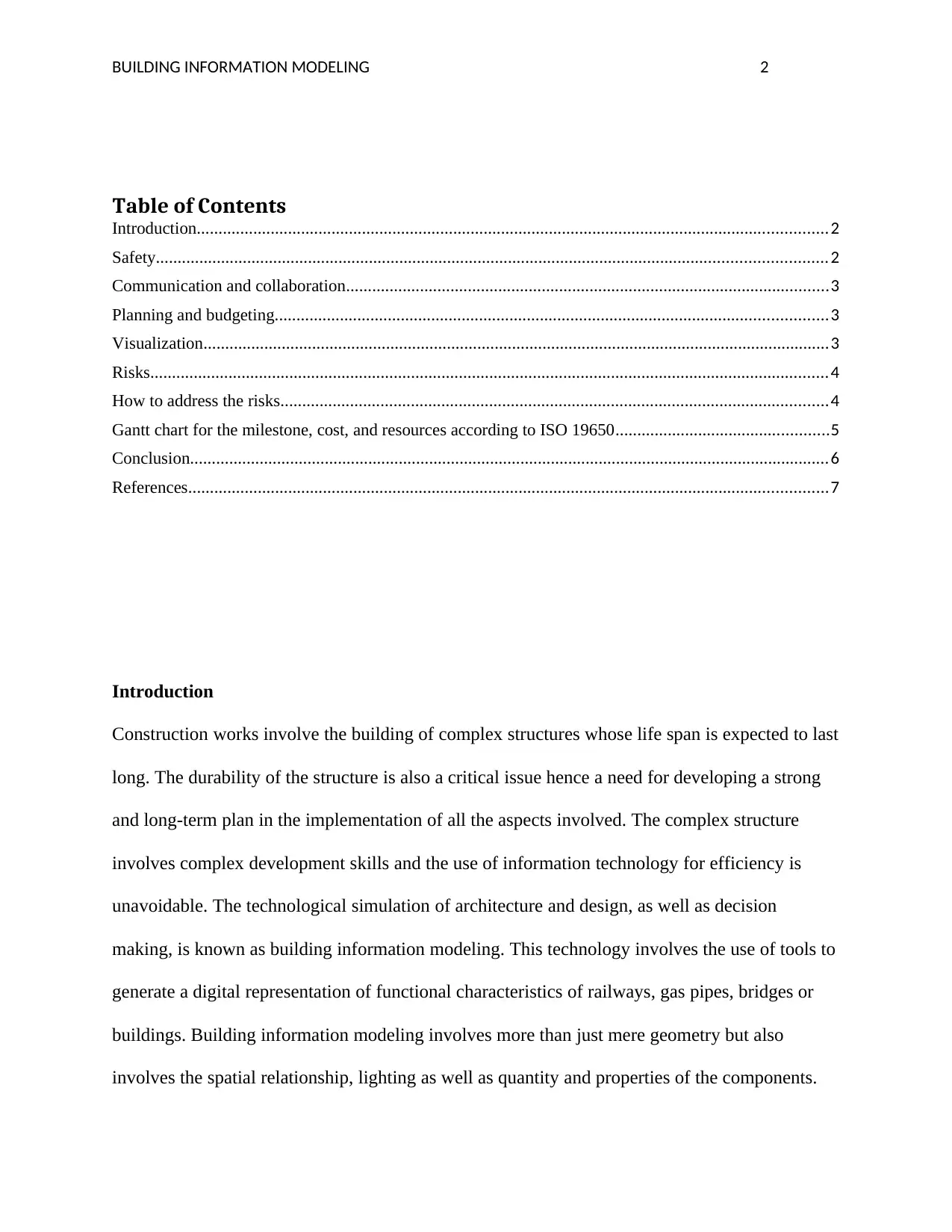
BUILDING INFORMATION MODELING 2
Table of Contents
Introduction.................................................................................................................................................2
Safety..........................................................................................................................................................2
Communication and collaboration...............................................................................................................3
Planning and budgeting...............................................................................................................................3
Visualization................................................................................................................................................3
Risks............................................................................................................................................................4
How to address the risks..............................................................................................................................4
Gantt chart for the milestone, cost, and resources according to ISO 19650.................................................5
Conclusion...................................................................................................................................................6
References...................................................................................................................................................7
Introduction
Construction works involve the building of complex structures whose life span is expected to last
long. The durability of the structure is also a critical issue hence a need for developing a strong
and long-term plan in the implementation of all the aspects involved. The complex structure
involves complex development skills and the use of information technology for efficiency is
unavoidable. The technological simulation of architecture and design, as well as decision
making, is known as building information modeling. This technology involves the use of tools to
generate a digital representation of functional characteristics of railways, gas pipes, bridges or
buildings. Building information modeling involves more than just mere geometry but also
involves the spatial relationship, lighting as well as quantity and properties of the components.
Table of Contents
Introduction.................................................................................................................................................2
Safety..........................................................................................................................................................2
Communication and collaboration...............................................................................................................3
Planning and budgeting...............................................................................................................................3
Visualization................................................................................................................................................3
Risks............................................................................................................................................................4
How to address the risks..............................................................................................................................4
Gantt chart for the milestone, cost, and resources according to ISO 19650.................................................5
Conclusion...................................................................................................................................................6
References...................................................................................................................................................7
Introduction
Construction works involve the building of complex structures whose life span is expected to last
long. The durability of the structure is also a critical issue hence a need for developing a strong
and long-term plan in the implementation of all the aspects involved. The complex structure
involves complex development skills and the use of information technology for efficiency is
unavoidable. The technological simulation of architecture and design, as well as decision
making, is known as building information modeling. This technology involves the use of tools to
generate a digital representation of functional characteristics of railways, gas pipes, bridges or
buildings. Building information modeling involves more than just mere geometry but also
involves the spatial relationship, lighting as well as quantity and properties of the components.

BUILDING INFORMATION MODELING 3
In this strategy of building an information model, Revit modeling software is ideal on the
grounds of its cost-effectiveness which ranges around $2310.00 per year. This cost-effectiveness
is also further supported by the free trial period (Liu, Van Nederveen, & Hertogh, 2017). The
primary objective of using Revit information modeling for construction is to ensure competent
management and implementation as far as setting up of the structure of interest is concerned. The
project in the discussion is the construction of St-Louis villa under the leadership of Adam
Smith. The major milestones of the project include finishing the architectural design work within
the first week of the project. Other major milestones are explained in the Gantt chart.
Safety
At the end of the entire process with the use of Revit software in building information modeling,
I expect the outstanding outcome in the sense of improved and proficient scheduling of duties. I
also expect an outcome that is of higher productivity and prefabrication. The software will also
improve the articulation of issues and improvement of the security and safety measures on
human power hence reducing the number of health risks and hazards.
Communication and collaboration
In the long run, with the use of Revit modeling software, I expect to achieve better collaboration
and communication throughout the construction process. This is facilitated by enabling the
sharing of ideas and versions that cannot be shared in paperwork (Dainty, Leiringer, Fernie, &
Harty, 2017). Modeling further makes collaboration and communication easier through the use
of the cloud. Efficient communication and collaboration are always a step away from the success
of the plan at hand.
In this strategy of building an information model, Revit modeling software is ideal on the
grounds of its cost-effectiveness which ranges around $2310.00 per year. This cost-effectiveness
is also further supported by the free trial period (Liu, Van Nederveen, & Hertogh, 2017). The
primary objective of using Revit information modeling for construction is to ensure competent
management and implementation as far as setting up of the structure of interest is concerned. The
project in the discussion is the construction of St-Louis villa under the leadership of Adam
Smith. The major milestones of the project include finishing the architectural design work within
the first week of the project. Other major milestones are explained in the Gantt chart.
Safety
At the end of the entire process with the use of Revit software in building information modeling,
I expect the outstanding outcome in the sense of improved and proficient scheduling of duties. I
also expect an outcome that is of higher productivity and prefabrication. The software will also
improve the articulation of issues and improvement of the security and safety measures on
human power hence reducing the number of health risks and hazards.
Communication and collaboration
In the long run, with the use of Revit modeling software, I expect to achieve better collaboration
and communication throughout the construction process. This is facilitated by enabling the
sharing of ideas and versions that cannot be shared in paperwork (Dainty, Leiringer, Fernie, &
Harty, 2017). Modeling further makes collaboration and communication easier through the use
of the cloud. Efficient communication and collaboration are always a step away from the success
of the plan at hand.
⊘ This is a preview!⊘
Do you want full access?
Subscribe today to unlock all pages.

Trusted by 1+ million students worldwide
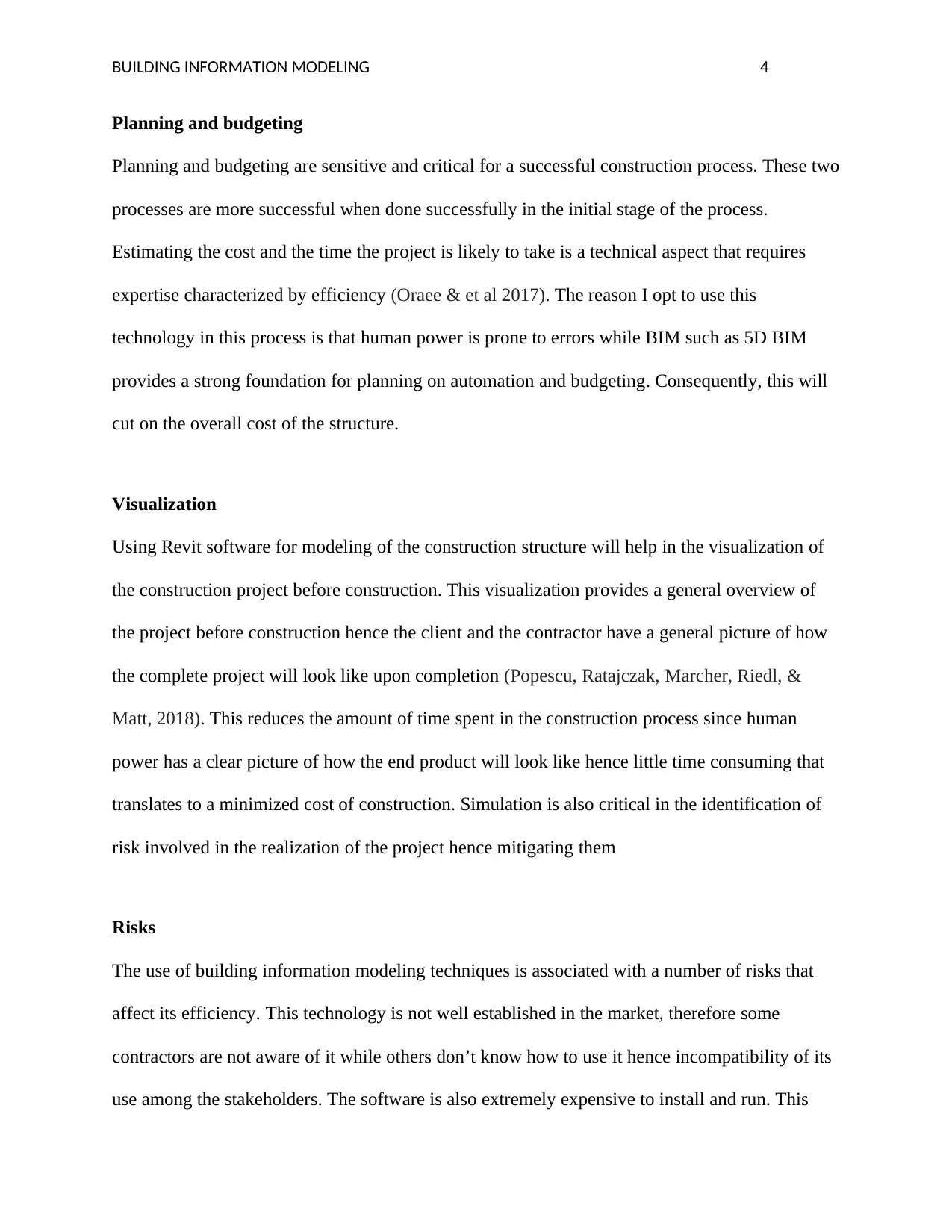
BUILDING INFORMATION MODELING 4
Planning and budgeting
Planning and budgeting are sensitive and critical for a successful construction process. These two
processes are more successful when done successfully in the initial stage of the process.
Estimating the cost and the time the project is likely to take is a technical aspect that requires
expertise characterized by efficiency (Oraee & et al 2017). The reason I opt to use this
technology in this process is that human power is prone to errors while BIM such as 5D BIM
provides a strong foundation for planning on automation and budgeting. Consequently, this will
cut on the overall cost of the structure.
Visualization
Using Revit software for modeling of the construction structure will help in the visualization of
the construction project before construction. This visualization provides a general overview of
the project before construction hence the client and the contractor have a general picture of how
the complete project will look like upon completion (Popescu, Ratajczak, Marcher, Riedl, &
Matt, 2018). This reduces the amount of time spent in the construction process since human
power has a clear picture of how the end product will look like hence little time consuming that
translates to a minimized cost of construction. Simulation is also critical in the identification of
risk involved in the realization of the project hence mitigating them
Risks
The use of building information modeling techniques is associated with a number of risks that
affect its efficiency. This technology is not well established in the market, therefore some
contractors are not aware of it while others don’t know how to use it hence incompatibility of its
use among the stakeholders. The software is also extremely expensive to install and run. This
Planning and budgeting
Planning and budgeting are sensitive and critical for a successful construction process. These two
processes are more successful when done successfully in the initial stage of the process.
Estimating the cost and the time the project is likely to take is a technical aspect that requires
expertise characterized by efficiency (Oraee & et al 2017). The reason I opt to use this
technology in this process is that human power is prone to errors while BIM such as 5D BIM
provides a strong foundation for planning on automation and budgeting. Consequently, this will
cut on the overall cost of the structure.
Visualization
Using Revit software for modeling of the construction structure will help in the visualization of
the construction project before construction. This visualization provides a general overview of
the project before construction hence the client and the contractor have a general picture of how
the complete project will look like upon completion (Popescu, Ratajczak, Marcher, Riedl, &
Matt, 2018). This reduces the amount of time spent in the construction process since human
power has a clear picture of how the end product will look like hence little time consuming that
translates to a minimized cost of construction. Simulation is also critical in the identification of
risk involved in the realization of the project hence mitigating them
Risks
The use of building information modeling techniques is associated with a number of risks that
affect its efficiency. This technology is not well established in the market, therefore some
contractors are not aware of it while others don’t know how to use it hence incompatibility of its
use among the stakeholders. The software is also extremely expensive to install and run. This
Paraphrase This Document
Need a fresh take? Get an instant paraphrase of this document with our AI Paraphraser
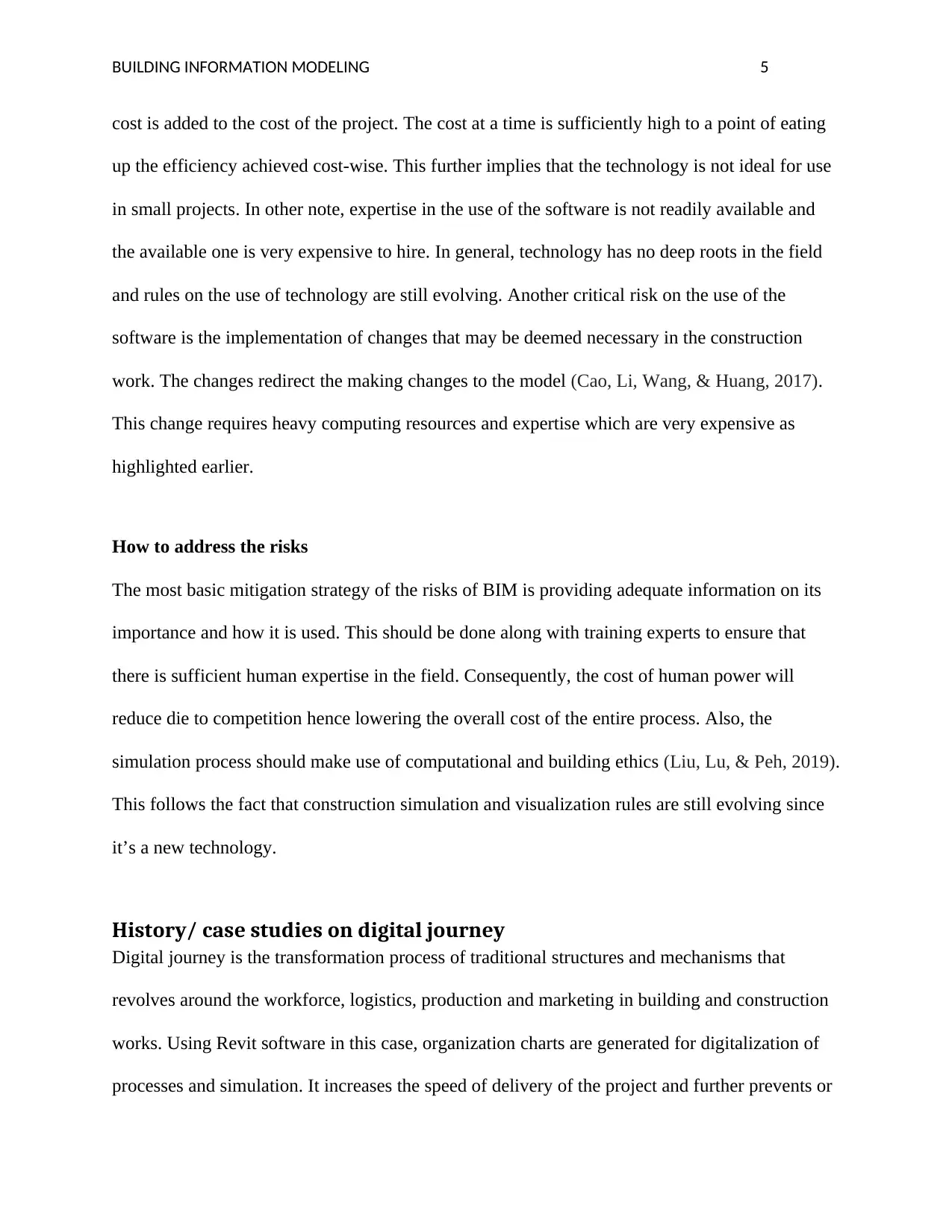
BUILDING INFORMATION MODELING 5
cost is added to the cost of the project. The cost at a time is sufficiently high to a point of eating
up the efficiency achieved cost-wise. This further implies that the technology is not ideal for use
in small projects. In other note, expertise in the use of the software is not readily available and
the available one is very expensive to hire. In general, technology has no deep roots in the field
and rules on the use of technology are still evolving. Another critical risk on the use of the
software is the implementation of changes that may be deemed necessary in the construction
work. The changes redirect the making changes to the model (Cao, Li, Wang, & Huang, 2017).
This change requires heavy computing resources and expertise which are very expensive as
highlighted earlier.
How to address the risks
The most basic mitigation strategy of the risks of BIM is providing adequate information on its
importance and how it is used. This should be done along with training experts to ensure that
there is sufficient human expertise in the field. Consequently, the cost of human power will
reduce die to competition hence lowering the overall cost of the entire process. Also, the
simulation process should make use of computational and building ethics (Liu, Lu, & Peh, 2019).
This follows the fact that construction simulation and visualization rules are still evolving since
it’s a new technology.
History/ case studies on digital journey
Digital journey is the transformation process of traditional structures and mechanisms that
revolves around the workforce, logistics, production and marketing in building and construction
works. Using Revit software in this case, organization charts are generated for digitalization of
processes and simulation. It increases the speed of delivery of the project and further prevents or
cost is added to the cost of the project. The cost at a time is sufficiently high to a point of eating
up the efficiency achieved cost-wise. This further implies that the technology is not ideal for use
in small projects. In other note, expertise in the use of the software is not readily available and
the available one is very expensive to hire. In general, technology has no deep roots in the field
and rules on the use of technology are still evolving. Another critical risk on the use of the
software is the implementation of changes that may be deemed necessary in the construction
work. The changes redirect the making changes to the model (Cao, Li, Wang, & Huang, 2017).
This change requires heavy computing resources and expertise which are very expensive as
highlighted earlier.
How to address the risks
The most basic mitigation strategy of the risks of BIM is providing adequate information on its
importance and how it is used. This should be done along with training experts to ensure that
there is sufficient human expertise in the field. Consequently, the cost of human power will
reduce die to competition hence lowering the overall cost of the entire process. Also, the
simulation process should make use of computational and building ethics (Liu, Lu, & Peh, 2019).
This follows the fact that construction simulation and visualization rules are still evolving since
it’s a new technology.
History/ case studies on digital journey
Digital journey is the transformation process of traditional structures and mechanisms that
revolves around the workforce, logistics, production and marketing in building and construction
works. Using Revit software in this case, organization charts are generated for digitalization of
processes and simulation. It increases the speed of delivery of the project and further prevents or
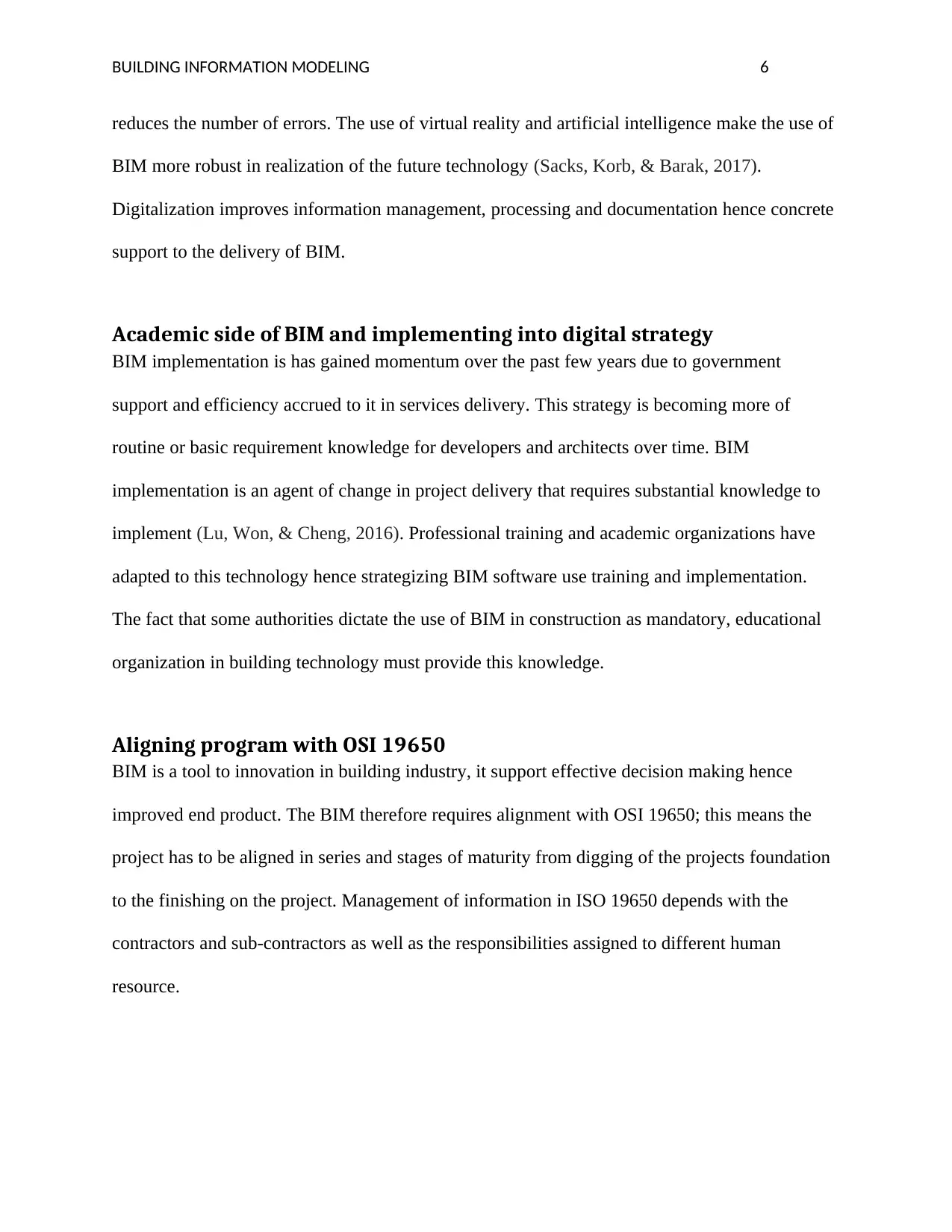
BUILDING INFORMATION MODELING 6
reduces the number of errors. The use of virtual reality and artificial intelligence make the use of
BIM more robust in realization of the future technology (Sacks, Korb, & Barak, 2017).
Digitalization improves information management, processing and documentation hence concrete
support to the delivery of BIM.
Academic side of BIM and implementing into digital strategy
BIM implementation is has gained momentum over the past few years due to government
support and efficiency accrued to it in services delivery. This strategy is becoming more of
routine or basic requirement knowledge for developers and architects over time. BIM
implementation is an agent of change in project delivery that requires substantial knowledge to
implement (Lu, Won, & Cheng, 2016). Professional training and academic organizations have
adapted to this technology hence strategizing BIM software use training and implementation.
The fact that some authorities dictate the use of BIM in construction as mandatory, educational
organization in building technology must provide this knowledge.
Aligning program with OSI 19650
BIM is a tool to innovation in building industry, it support effective decision making hence
improved end product. The BIM therefore requires alignment with OSI 19650; this means the
project has to be aligned in series and stages of maturity from digging of the projects foundation
to the finishing on the project. Management of information in ISO 19650 depends with the
contractors and sub-contractors as well as the responsibilities assigned to different human
resource.
reduces the number of errors. The use of virtual reality and artificial intelligence make the use of
BIM more robust in realization of the future technology (Sacks, Korb, & Barak, 2017).
Digitalization improves information management, processing and documentation hence concrete
support to the delivery of BIM.
Academic side of BIM and implementing into digital strategy
BIM implementation is has gained momentum over the past few years due to government
support and efficiency accrued to it in services delivery. This strategy is becoming more of
routine or basic requirement knowledge for developers and architects over time. BIM
implementation is an agent of change in project delivery that requires substantial knowledge to
implement (Lu, Won, & Cheng, 2016). Professional training and academic organizations have
adapted to this technology hence strategizing BIM software use training and implementation.
The fact that some authorities dictate the use of BIM in construction as mandatory, educational
organization in building technology must provide this knowledge.
Aligning program with OSI 19650
BIM is a tool to innovation in building industry, it support effective decision making hence
improved end product. The BIM therefore requires alignment with OSI 19650; this means the
project has to be aligned in series and stages of maturity from digging of the projects foundation
to the finishing on the project. Management of information in ISO 19650 depends with the
contractors and sub-contractors as well as the responsibilities assigned to different human
resource.
⊘ This is a preview!⊘
Do you want full access?
Subscribe today to unlock all pages.

Trusted by 1+ million students worldwide
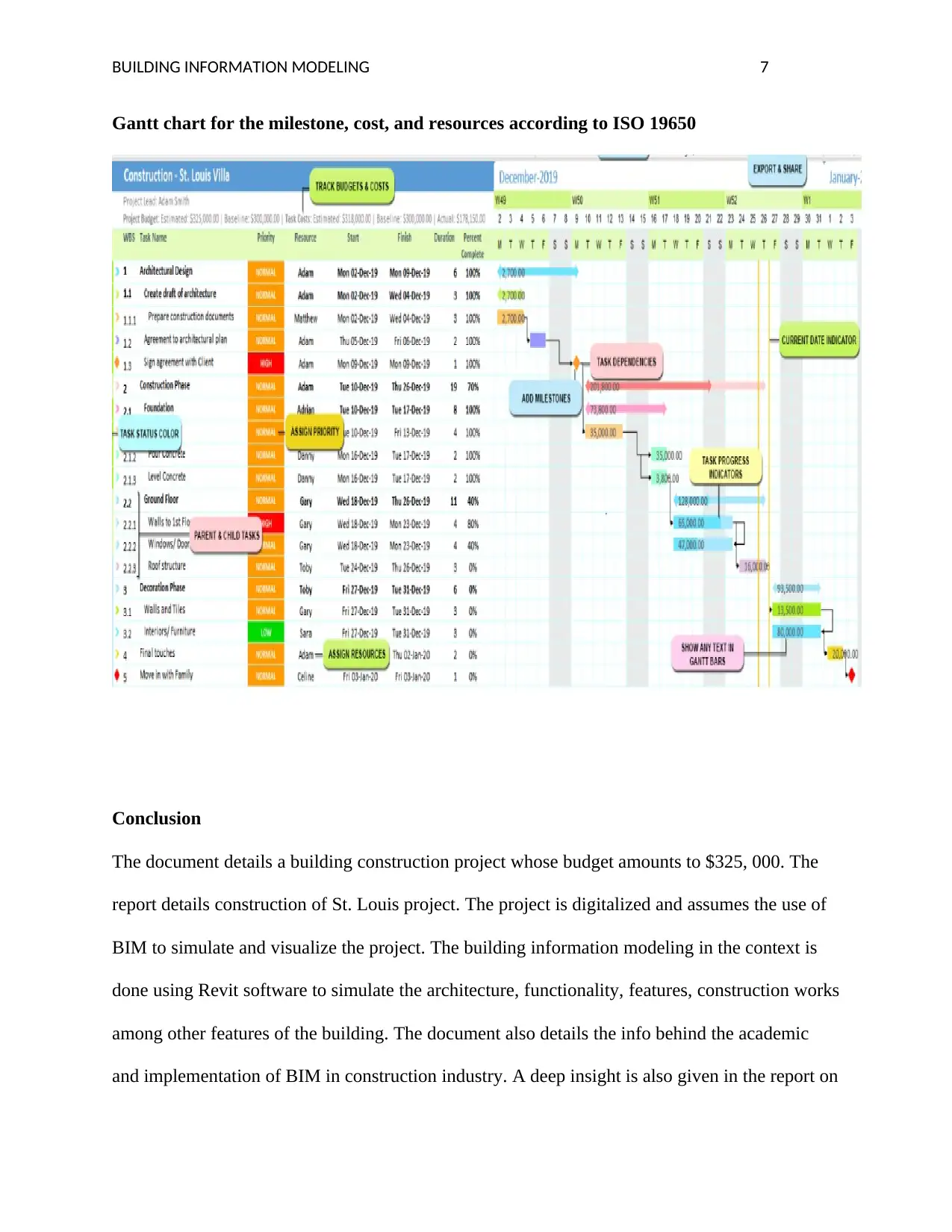
BUILDING INFORMATION MODELING 7
Gantt chart for the milestone, cost, and resources according to ISO 19650
Conclusion
The document details a building construction project whose budget amounts to $325, 000. The
report details construction of St. Louis project. The project is digitalized and assumes the use of
BIM to simulate and visualize the project. The building information modeling in the context is
done using Revit software to simulate the architecture, functionality, features, construction works
among other features of the building. The document also details the info behind the academic
and implementation of BIM in construction industry. A deep insight is also given in the report on
Gantt chart for the milestone, cost, and resources according to ISO 19650
Conclusion
The document details a building construction project whose budget amounts to $325, 000. The
report details construction of St. Louis project. The project is digitalized and assumes the use of
BIM to simulate and visualize the project. The building information modeling in the context is
done using Revit software to simulate the architecture, functionality, features, construction works
among other features of the building. The document also details the info behind the academic
and implementation of BIM in construction industry. A deep insight is also given in the report on
Paraphrase This Document
Need a fresh take? Get an instant paraphrase of this document with our AI Paraphraser

BUILDING INFORMATION MODELING 8
the digitalization journey and its role in the project. The document is also characterized by a
Gantt chart that shows the major milestones of the project. The entire project observes ISO
19650.
the digitalization journey and its role in the project. The document is also characterized by a
Gantt chart that shows the major milestones of the project. The entire project observes ISO
19650.

BUILDING INFORMATION MODELING 9
References
Cao, D., Li, H., Wang, G. and Huang, T., 2017. Identifying and contextualising the motivations
for BIM implementation in construction projects: An empirical study in China. International
journal of project management, 35(4), pp.658-669.
Dainty, A., Leiringer, R., Fernie, S. and Harty, C., 2017. BIM and the small construction firm: a
critical perspective. Building research & information, 45(6), pp.696-709.
Liu, Y., Van Nederveen, S. and Hertogh, M., 2017. Understanding effects of BIM on
collaborative design and construction: An empirical study in China. International Journal of
Project Management, 35(4), pp.686-698.
Liu, Z., Lu, Y. and Peh, L.C., 2019. A review and scientometric analysis of global 2 Building
Information Modelling (BIM) research in 3 the Architecture, Engineering and Construction 4
(AEC) industry 5.
Lu, Q., Won, J. and Cheng, J.C., 2016. A financial decision making framework for construction
projects based on 5D Building Information Modeling (BIM). International Journal of Project
Management, 34(1), pp.3-21.
Oraee, M., Hosseini, M.R., Papadonikolaki, E., Palliyaguru, R. and Arashpour, M., 2017.
Collaboration in BIM-based construction networks: A bibliometric-qualitative literature
review. International Journal of Project Management, 35(7), pp.1288-1301.
Popescu, A., Ratajczak, J., Marcher, C., Riedl, M. and Matt, D., 2018, December. Development
of a Digital Platform Based on the Integration of Augmented Reality and BIM for the
Management of Information in Construction Processes. In Product Lifecycle Management to
References
Cao, D., Li, H., Wang, G. and Huang, T., 2017. Identifying and contextualising the motivations
for BIM implementation in construction projects: An empirical study in China. International
journal of project management, 35(4), pp.658-669.
Dainty, A., Leiringer, R., Fernie, S. and Harty, C., 2017. BIM and the small construction firm: a
critical perspective. Building research & information, 45(6), pp.696-709.
Liu, Y., Van Nederveen, S. and Hertogh, M., 2017. Understanding effects of BIM on
collaborative design and construction: An empirical study in China. International Journal of
Project Management, 35(4), pp.686-698.
Liu, Z., Lu, Y. and Peh, L.C., 2019. A review and scientometric analysis of global 2 Building
Information Modelling (BIM) research in 3 the Architecture, Engineering and Construction 4
(AEC) industry 5.
Lu, Q., Won, J. and Cheng, J.C., 2016. A financial decision making framework for construction
projects based on 5D Building Information Modeling (BIM). International Journal of Project
Management, 34(1), pp.3-21.
Oraee, M., Hosseini, M.R., Papadonikolaki, E., Palliyaguru, R. and Arashpour, M., 2017.
Collaboration in BIM-based construction networks: A bibliometric-qualitative literature
review. International Journal of Project Management, 35(7), pp.1288-1301.
Popescu, A., Ratajczak, J., Marcher, C., Riedl, M. and Matt, D., 2018, December. Development
of a Digital Platform Based on the Integration of Augmented Reality and BIM for the
Management of Information in Construction Processes. In Product Lifecycle Management to
⊘ This is a preview!⊘
Do you want full access?
Subscribe today to unlock all pages.

Trusted by 1+ million students worldwide

BUILDING INFORMATION MODELING 10
Support Industry 4.0: 15th IFIP WG 5.1 International Conference, PLM 2018, Turin, Italy, July
2-4, 2018, Proceedings (Vol. 540, p. 46). Springer.
Sacks, R., Korb, S. and Barak, R., 2017. Building lean, building BIM: improving construction
the Tidhar way. Routledge.
Support Industry 4.0: 15th IFIP WG 5.1 International Conference, PLM 2018, Turin, Italy, July
2-4, 2018, Proceedings (Vol. 540, p. 46). Springer.
Sacks, R., Korb, S. and Barak, R., 2017. Building lean, building BIM: improving construction
the Tidhar way. Routledge.
1 out of 10
Related Documents
Your All-in-One AI-Powered Toolkit for Academic Success.
+13062052269
info@desklib.com
Available 24*7 on WhatsApp / Email
![[object Object]](/_next/static/media/star-bottom.7253800d.svg)
Unlock your academic potential
Copyright © 2020–2025 A2Z Services. All Rights Reserved. Developed and managed by ZUCOL.





